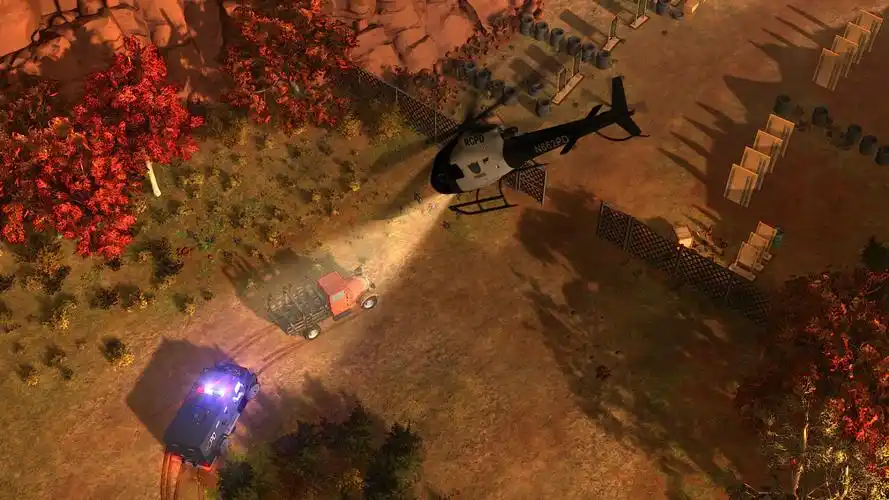Of Curses and Contracts: My Days as a VR Sign Installer in the Fae Realm
Tags: #VRGaming #SimulationGames #FantasyHumor #IndieGameReview #VRAdventure #WhimsicalHorror #GameDesign #FairyTale #TechMagic #ImmersiveSim
The job posting was… unconventional. “Contractor sought for interdimensional signage installation. Hazard pay included. VR headset required. Liability waiver mandatory.” As a freelance VR sim operator between gigs, I’d seen weirder. But nothing could have prepared me for the surreal, terrifying, and oddly bureaucratic experience of the “Fairy Curse Shelter Sign Installer Simulator VR: Mount Missions Expansion.”
Boot-up is a familiar affair. The sterile, grey menu room of the base game is still there, a monument to functional human design. But now, a new portal shimmers with iridescent light—a swirling vortex of gossamer and thorns. Selecting it triggers a disorienting lurch, the grey walls dissolving into a hyper-saturated panorama of the Whispering Spires. This isn't just a new map; it's a full sensory assault. The air hums with latent magic, the scent of ozone and petrichor is overwhelming, and the vertigo is very, very real. My virtual stomach does a backflip. The expansion is live.
The core gameplay loop remains deceptively simple: receive a work order, navigate to the designated location, and install a brightly colored, human-engineered “Fairy Curse Shelter” sign. These signs, with their clear pictograms (a fairy inside a red circle with a slash next to a weeping gnome), are beacons of bureaucratic order in a realm of pure, chaotic whimsy. The genius of the Mount Missions expansion is how it contorts this simple task into an epic struggle against geography, physics, and the deeply offended local fauna.
My first assignment is at “Glimmerwing Ledge.” The work order, scrawled on animated, talking parchment that complains about the ink quality, specifies a Class-3 Hazard zone. This translates to “the cliff face is vertical, made of slick, magic-infused crystal, and home to nesting Roc-feather Falcons who consider power tools a personal insult.”

Gone are the simple ladders of the base game. My toolkit has received a fae-approved upgrade. I now have a “Gecko-Grip Gauntlet” for one hand, allowing me to cling to most semi-organic surfaces, and a “Pixie-Powered Pneumatic Driver” for the other, which is less a tool and more a temperamental pet that drives screws when it feels like it. My primary mode of transport is a rickety “Cloud-Skimmer Gondola,” a basket suspended from a flock of disgruntled, migratory sky-sheep. Steering involves bribing the alpha sheep with virtual energy pellets. It’s less flying and more suggesting a direction very, very politely.
Reaching the installation point is 90% of the battle. It’s a harrowing climb. The Gecko-Grip gauntlet occasionally loses purchase for a dramatic half-second, sending shards of virtual crystal skittering into the abyss below. A misclick sends my drill, the Whirly-burly 5000, tumbling into the mist. I have to slowly abseil down to retrieve it, all while the falcons dive-bomb my head, their screeches translated by the universal translator as furious critiques of my safety protocols and parentage.
This is where the VR immersion shines. Leaning out over a 2,000-foot drop to get the perfect angle for a screw is a white-knuckle experience. My real arms ache with the strain of holding the virtual drill steady. The haptic feedback sells every impact—the satisfying thunk as the anchor bites into the rock, the violent shudder as a disgruntled earth elemental strolls past, shaking the entire mountainside.
The fairies themselves are the real environmental hazard. They don’t attack directly; that would be uncouth. Instead, they cast “minor inconveniences.” As I’m lining up a post, one might flutter by and cast a “Gravity Inversion” curse on my toolbelt. My wrenches and screws suddenly float upwards, and I’m left frantically swiping at them as they drift toward the sun. Another might hit me with a “Linguistic Lobotomy,” temporarily replacing all the UI text and audio cues with incomprehensible, melodic squeaking. Try reading a safety manual when it’s written in frantic harp glissandos.
The peak of the expansion’s design is the “Titan’s Tread” mission. The installation site is not on a static mountain, but on the knee joint of a slumbering Mountain Titan. The “geography” is actively breathing and shifting. I have to time my drilling between seismic snores. The “local wildlife” is a colony of rock mites that consider the titanium signpost a delicacy and try to nibble it down as I’m installing it. It’s a frantic, hilarious dance of precision and panic, a boss fight where the boss is geology itself and your only weapon is a well-secured bolt.
Upon successfully mounting the final bolt and activating the sign’s anti-curse field (which produces a soothing, corporate jingle that visibly irritates the nearby sprites), the payoff is immense. A notification pops up: “Hazard Zone Secured. Contract Fulfilled. Bonus: +50% for Aesthetic Symmetry.” I look back at my work. The garish yellow sign is a grotesque yet beautiful eyesore, a stark testament of human practicality standing defiant against the overwhelming, magical sublime. I’ve not slain a dragon or completed a epic quest. I’ve performed a public service. A weird, dangerous, and deeply absurd one.
Fairy Curse Shelter Sign Installer VR: Mount Missions Expansion is a masterpiece of genre-blending. It takes the mundane satisfaction of a job simulator and hurls it into a world where myth and manual labor collide. It’s a game about the quiet heroism of the working class, even when that work is done while dangling from a sheep-powered basket over a bottomless chasm, being mocked by a cloud of immortal, prank-loving vermin. It’s the most fun I’ve never wanted to have again. Now, if you’ll excuse me, I have a waiver to sign for the upcoming “Swamp of Perpetual Malaise” DLC. The benefits are terrible, but the view is unbelievable.















